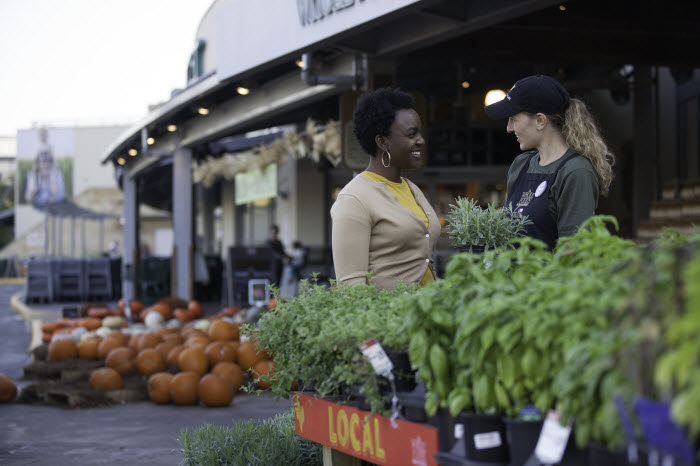The grocer’s outreach to include “Friends,” such as bike repair shops, in its new 365 stores shows the natural-foods chain understands that customers cannot be captured with lower prices alone. Is a sense of community the future of the grocery experience, or is it simply a trendier approach to capturing the non-food dollar?
If the descriptions are accurate, a trip through a soon-to-open 365 store by Whole Foods would be akin to strolling up the hippest areas of Main Street.
Vegan Asian noodles? Check. The latest vinyl by the Lumineers? Check. Wrist tat? Check!
This could be the case, if Whole Foods picks its friends right.
The natural-foods chain is preparing to open the first of its more affordable 365 stores and is, in describing its strategy, making it clear its potential market cannot be captured simply with lower prices.
Whole Foods also wants to include in its 365 stores compatible merchants or “Friends,” which can range from tattoo parlors to record shops. And so the grocery world turns: Does this mean Main Street is the future of the supermarket experience, or is it simply a trendier approach to capturing the non-food dollar?
Veering from food is hardly new in the industry. Grocery chains have for years combined non-traditional services and goods in a bid to keep shoppers longer and spend more. In addition to the now-common pharmacy, coffee shop and florist, today’s shopper can find – not far from the bananas and bread – an assortment of coffee presses, decorative vases and restaurants.
We’re also seeing more of the kinds of attractions common among European hypermarchés, which offer nurseries, snack areas and cooking classes. Kroger, for example, is dedicating significant square footage to shoes and apparel in addition to its Fred Meyer Jeweler stores.
Beyond Shopping
Whole Foods, however, is getting intimate while many grocers are scaling large.
It is seeking highly localized partners that would extend the shopping experience beyond actual shopping, a likely effort not only to get customers to spend more but also to visit the store more frequently. In addition to carrots and crackers, shoppers of 365 could find, potentially, representatives of a local bike shop, a seaweed hair care line or a kid-fitness program.
The critical distinguishing factor here is that these Friends will be local to each store.
“Friends of 365 are independent businesses who bring their special mojo to our 365 stores,” the website states. “Friends can be any type of business — Record shop? Tattoo parlor? Maybe! And each 365 store may have a different mix of friends. The more variety, the merrier!”
Among the qualifications of joining the Friends program: The products and services should align with the quality and values of 365; the Friends should be independent businesses; and the Friends must offer something “powerful, something new and exciting, or known and trusted, but hip and cool for sure.”
The retailer also specifies it is looking for startups as well as established brands across categories. “We’re looking for Friends with a strong offering and personality.”
13 In ’16
Enthusiasm aside, the chance of becoming a 365 Friend in 2016 is still limited.
Whole Foods has signed leases to open 13 such locations this year, according to its first-quarter report. The first, in Silver Lake, Calif., will open in May, accompanied in the following months by stores in Lake Oswego, Ore., and Bellevue, Wash.
The measured expansion gives 365 plenty of needed time to pick its Friends, whose inclusion needs to benefit the parent company as well as shoppers and community. Otherwise, it wouldn’t work.
Which directs us back to the question: Is the Friends program simply a trendier approach to capturing the non-food dollar? There is no denying it is trendy (the site’s language approaches the tragically hip), but Whole Foods has not lost its head. The Friends program is built on, and contingent upon, community, which is a crucially smart decision.
Friends selected for the program are responsible for all operations, including staffing and making the space their own, according to a fall 2015 call for candidates. Applicants were asked to submit videos, which were voted upon by the public and 365 staff. Those selected candidates were then invited to Austin, Texas, (base camp of Whole Foods) to make their pitches.
“By combining our strengths and yours — plus a whole horde of like-minded shoppers — we’ll create that all-important synergy that grows businesses,” the Friends of 365 website states. “We’ll also have a super cool [sic] hang.”
Partners With Familiar Faces
I do not know of many national chains that refer to their retail partnerships as super-cool hangs, which may be precisely what distinguishes the Friends program from other retail collaborations. It is focused, laser-like, on a particular customer – one who wants to support her community.
But when you get down to it, don’t we all? It’s aspirational.
Look, partnerships among merchants are old business. Stores-within-stores have existed for years, including J.C. Penney and Sephora, Best Buy and Samsung, Kroger and Starbucks and, recently, CVS and Target. These collaborations help expose each brand’s offerings to the other’s core customer base, and they importantly provide a revenue stream called rent.
Whole Foods’ Friends strategy, however, blends local personalities with a national, publicly traded one. More simply, it puts a familiar face on a major corporation. Few companies can do this well. Whole Foods is attempting it by creating a whole new body for the face.
Tattoo artists and sushi rollers may not realize it, or even approve, but if Whole Foods succeeds and gets some mojo from Main Street, then it may make it a darling of Wall Street.
This article originally appeared on Forbes.com, you can view the original story here.
